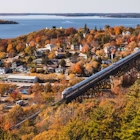

Camping under the stars in New Zealand.
As countries around the world begin announcing the relaxation of lockdowns, the concept of ‘bubbles’ is gaining traction. The idea has emerged in the last few days on opposite sides of the earth – in Australia and New Zealand, and on Canada’s Atlantic coast. These ‘bubbles’ offer safe spaces in which people can mingle. And they could also gradually unlock borders, and get the world travelling again.
- placement: fullWidth
- path: articles/in-content-top
- possible size: [970, 250], [970, 90], [728, 90], [300, 250], [320, 50], [1, 1],
- targeting:
{ "url": "post-covid19-travel" }

In New Brunswick, a largely rural Canadian province known for its forests and shoreline that’s had relatively few cases of COVID-19, the government has issued guidelines that allow residents to invite friends to join their bubble. “To reduce social isolation,” explain its guidelines, “your household can join up with one other household, if both households mutually agree. This would allow you to visit, have a meal and enjoy the company of another household bubble.” Chief medical officer Dr Jennifer Russell underlined that the figure of two is a start point, telling a press conference that “if we continue to see good results this may be expanded in the weeks ahead”.
- placement: fullWidth
- path: articles/in-content-middle
- possible size: [970, 250], [970, 90], [728, 90], [300, 250], [320, 50], [1, 1],
- targeting:
{ "url": "post-covid19-travel" }
New Zealand is also using the concept of bubbles, and since 27 April, residents have been instructed that they may “slightly extend your household bubble to include people such as close family members, caregivers or someone who needs care”.
A more ambitious model that could see travel bubbles encompass several countries has been floated in the region. With Australia and New Zealand currently making similar progress in containing COVID-19, their governments have discussed forming a bubble that would allow citizens of the two countries to travel between them. Australian prime minister Scott Morrison said last week that “if there is any country in the world with whom we can reconnect with first, undoubtedly that’s New Zealand”.

Given domestic travel is still restricted in both nations, any such change is likely to come in the second half of 2020. Air New Zealand’s chief revenue officer Cam Wallace is cautiously optimistic about staggered opening. “We expect our domestic market to start up first, then Tasman and Pacific markets and last of all, our international markets – potentially on a country by country basis,” he told Lonely Planet. “The timeline is very uncertain and will be driven by government responses and management of the virus from around the world, rather than any airline or industry.”
- placement: native
- path: articles/in-content-native
- possible size: [f, l],
- targeting:
{ "url": "post-covid19-travel" }
Australia is similarly focused on the gradual expansion. “Domestic tourism contributes about two-thirds of the visitor economy,” Tourism Australia managing director Phillipa Harrison told Lonely Planet. “As restrictions are gradually lifted it is likely that day trips close to home will mark the first steps towards a domestic-led tourism recovery, and then travellers will likely shift to overnight intrastate trips and then interstate travel when it is safe to do so... we just don’t know when international restrictions will start to be lifted, nor how the process of restoring international travel will play out. But we will be ready to go back and go back at scale when the time is right.”

The road ahead is undeniably uncertain – early reports suggested that Singapore could be included in a Pacific bubble, but a rise in cases has made that less likely. But other bubbles look likely to emerge. EU near-neighbours Italy and Spain are easing their restrictions on a similar timeframe, while the UK and Ireland have maintained flight and ferry links through lockdown. And the governors of California, Washington, Oregon, Nevada and Colorado have said they will coordinate reopening.
Bubbles are not only self-contained, they’re also associated with light, air and everything from childhood games to champagne. With other governments, including the UK, beginning to discuss the idea of bubbles, the effervescent word might just offer the key to safely unlocking borders, and getting the world – and eager travellers – moving again.
Read more:
Could dogs with the ability to sniff out COVID-19 be coming to airports?
Airbnb's new cleaning procedures go into effect next month
25 surprising travel facts that’ll make you see the world in a whole new light
- placement: fullWidth
- path: articles/bottom
- possible size: [970, 250], [970, 90], [728, 90], [300, 250], [320, 50], [1, 1],
- targeting:
{ "url": "post-covid19-travel" }
Explore related stories

Festivals & Events
Christmas dinners around the world: choose your favorite festive dishesNov 22, 2024 • 5 min read

 Sustainable TravelCanada's 4 best train trips offer big country adventures
Sustainable TravelCanada's 4 best train trips offer big country adventuresNov 20, 2024 • 10 min read



 CyclingHow to plan a biking trip to New Zealand’s Southern Lakes and Central Otago regions
CyclingHow to plan a biking trip to New Zealand’s Southern Lakes and Central Otago regionsNov 11, 2024 • 4 min read

 Solo Travel20 expert solo travel tips for women from the Lonely Planet team
Solo Travel20 expert solo travel tips for women from the Lonely Planet teamOct 31, 2024 • 11 min read


